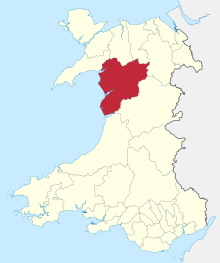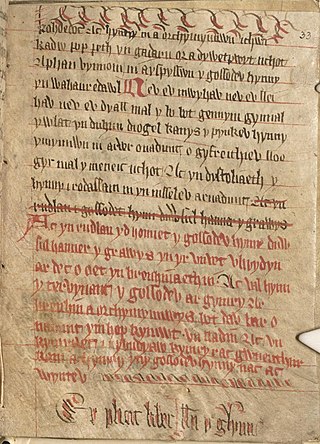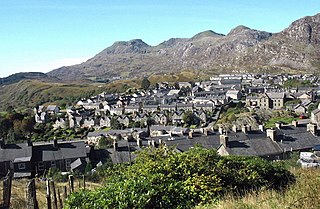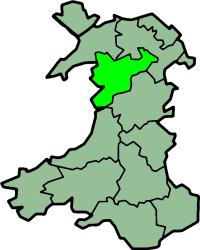

Meirionnydd is a coastal and mountainous region of Wales. It has been a kingdom, a cantref , a district and, as Merionethshire, a county. It is currently an committee area within the county Gwynedd.


Meirionnydd is a coastal and mountainous region of Wales. It has been a kingdom, a cantref , a district and, as Merionethshire, a county. It is currently an committee area within the county Gwynedd.
Meirionnydd (Meirion, with -ydd as a Welsh suffix of land, literally 'Land adjoined to Meirion') was a sub-kingdom of Gwynedd, founded according to legend by Meirion (derived from the Latin name Mariānus), a grandson of Cunedda, [1] a warrior-prince who brought his family to Wales from the Hen Ogledd (the 'Old North', northern England and southern Scotland today), probably in the early 5th century. His dynasty seems to have ruled there for the next four hundred years. The kingdom lay between the River Mawddach and the River Dovey, spreading in a north-easterly direction.

The ancient name of the cantref was Cantref Orddwy (or 'the cantref of the Ordovices'). The familiar name coming from Meirion's kingdom. [1]
The cantref of Meirionnydd held the presumed boundaries of the previous kingdom but now as a fief of the Kingdom of Gwynedd where it continued to enjoy long spells of relative independence. It was divided into the commotes of Ystumanner (administered from Castell y Bere at Llanfihangel-y-Pennant ) and Talybont (possibly centred on Llanegryn where there is a mound). [2] The cantref was effectively abolished in 1284 following the Statute of Rhuddlan with the area being reorganised with the addition of some neighbouring cantrefi to form the county of Merionethshire.
The area of Meirionnydd was enlarged under the Statute of Rhuddlan to become a county, gaining the old cantrefi of Penllyn and Ardudwy (shown as Dunoding in the map of medieval cantrefi). The name for the county was anglicised to the English phonetic equivalent of Merioneth, sometimes appearing with the suffix -shire as Merionethshire. [3]
Merioneth became an administrative county with an elected county council in 1889 under the Local Government Act 1888. In 1974 the administrative county was abolished with most of the area merging with Caernarfonshire and Anglesey to create a new county of Gwynedd.
| Meirionnydd | |
|---|---|
| District | |
 Meirionnydd shown within Wales | |
| Population | |
| • 1971 | 29,531[ citation needed ] |
| • 1992 (estimate) | 32,900[ citation needed ] |
| History | |
| • Created | 1 April 1974 |
| • Abolished | 31 March 1996 |
| • Succeeded by | Gwynedd |
| • HQ | Dolgellau |
The 1974 reforms established a two-tier system, with upper-tier county councils and lower-tier district councils. The county of Gwynedd was divided into five districts, one of which was called Meirionnydd, reverting to the Welsh spelling of the name Merioneth. [4] The district of Meirionnydd covered almost the same area as the pre-1974 county of Merioneth, excluding only the Edeirnion Rural District, which went to the Glyndŵr district of Clwyd. The Meirionnydd district replaced eight former districts: [5]
Under the Local Government (Wales) Act 1994, the previous two-tier system of counties and districts was replaced with new principal areas (each designated either a "county" or a "county borough"), whose councils perform the functions previously divided between the county and district councils. The Meirionnydd area merged with the neighbouring Arfon and Dwyfor districts to become a county, which the government originally named Caernarfonshire and Merionethshire. [6] During the transition to the new system, the shadow authority requested a change of name from Caernarfonshire and Merionethshire to Gwynedd. The government confirmed the change with effect from 2 April 1996, one day after the new council came into being. [7]
Since 1996, Gwynedd Council has used the former Meirionnydd district as a committee area for discussing local matters. [8]
The first election to Meirionnydd District Council was held in 1973, initially operating as a shadow authority alongside the outgoing authorities until it came into its powers on 1 April 1974. Throughout the council's existence a majority of the seats on the council were held by independents: [9]
| Party in control | Years | |
|---|---|---|
| Independent | 1974–1996 | |
The district council was based at Cae Penarlâg in Dolgellau , which had been built in 1953 as the headquarters of the old Merioneth County Council. Since 1996 the building has served as an area office of Gwynedd Council. [10]

Gwynedd is a county in the north-west of Wales. It borders Anglesey across the Menai Strait to the north, Conwy, Denbighshire, and Powys to the east, Ceredigion over the Dyfi estuary to the south, and the Irish Sea to the west. The city of Bangor is the largest settlement, and the administrative centre is Caernarfon. The preserved county of Gwynedd, which is used for ceremonial purposes, includes the Isle of Anglesey.

Until 1974, Caernarfonshire, sometimes spelled Caernarvonshire or Carnarvonshire, was an administrative county in the north-west of Wales, later classed as one of the thirteen historic counties of Wales.

Until 1974, Merionethshire or Merioneth was an administrative county in the north-west of Wales, later classed as one of the thirteen historic counties of Wales.

The Statute of Rhuddlan, also known as the Statutes of Wales or as the Statute of Wales, was a royal ordinance by Edward I of England, which gave the constitutional basis for the government of the Principality of Wales from 1284 until 1536.

Ffestiniog is a community in Gwynedd, Wales, containing several villages, in particular the settlements of Llan Ffestiniog and Blaenau Ffestiniog. It has a population of 4,875.

Dolgellau is a town and community in Gwynedd, north-west Wales, lying on the River Wnion, a tributary of the River Mawddach. It was the traditional county town of the historic county of Merionethshire until the county of Gwynedd was created in 1974. Dolgellau is the main base for climbers of Cadair Idris and Mynydd Moel which are visible from the town. Dolgellau is the second largest settlement in southern Gwynedd after Tywyn and includes the community of Penmaenpool.

The Borough of Aberconwy was a local government district with borough status from 1974 to 1996, being one of five districts in the county of Gwynedd, north-west Wales.

The Borough of Arfon was local government district with borough status from 1974 to 1996, being one of five districts in the county of Gwynedd, north-west Wales.

Dwyfor was one of the five local government districts of Gwynedd, Wales from 1974 to 1996, covering the Llŷn peninsula. Its council was based in Pwllheli.

The Borough of Rhuddlan was a local government district with borough status from 1974 to 1996, being one of six districts in the county of Clwyd, north-east Wales.

Gwynedd Council, which calls itself by its Welsh name Cyngor Gwynedd, is the governing body for the county of Gwynedd, one of the principal areas of Wales. The council administrates internally using the Welsh language.

Arfon was a mediaeval Welsh cantref in north-west Wales. It was the core of the kingdom of Gwynedd. Later it was included in the new county of Caernarfonshire, together with Llŷn and Arllechwedd under the terms of the Statute of Rhuddlan in 1284. The island of Anglesey faced it across the Menai Strait; to the east was the cantref of Arllechwedd, to the south the cantref of Eifionydd, and to the west was the cantref of Llŷn.

Arllechwedd was an ancient Welsh cantref in north-west Wales. It was part of the kingdom of Gwynedd for much of its history until it was included in the new county of Caernarfonshire, together with Arfon and Llŷn under the terms of the Statute of Rhuddlan in 1284.

Ystrad Tywi is a region of southwest Wales situated on both banks of the River Towy, it contained places such as Cedweli, Carnwyllion, Loughor, Llandeilo, and Gwyr. Although Ystrad Tywi was never a kingdom itself, it was historically a valuable territory and was fought over by the various kings of Dyfed, Deheubarth, Seisyllwg, Gwynedd, Morgannwg and the Normans.
The history of local government in Wales in a recognisably modern form emerged during the late 19th century. Administrative counties and county boroughs were first established in Wales in 1889. Urban and rural districts were formed in 1894. These were replaced in 1974 by a two-tier authority system across the country comprising eight counties and, within them, thirty-seven districts. This system was itself replaced by the introduction of 22 single-tier authorities in 1996.

Dunoding was an early sub-kingdom within the Kingdom of Gwynedd in north-west Wales that existed between the 5th and 10th centuries. According to tradition, it was named after Dunod, a son of the founding father of Gwynedd - Cunedda Wledig - who drove the Irish settlers from the area in c.460. The territory existed as a subordinate realm within Gwynedd until the line of rulers descended from Dunod expired in c.925. Following the end of the House of Dunod, it was split into the cantrefi of Eifionydd and Ardudwy and fully incorporated into Gwynedd. After the defeat of the kingdom of Gwynedd in 1283 and its annexation to England, the two cantrefi became parts of the counties of Caernarfonshire and Meirionnydd respectively. It is now part of the modern county of Gwynedd within a devolved Wales.

Edeirnion or Edeyrnion is an area of the county of Denbighshire and an ancient commote of medieval Wales in the cantref of Penllyn. According to tradition, it was named after its eponymous founder Edern or Edeyrn. It was included as a Welsh territory of Shropshire in the Domesday Book.

Penllyn was a medieval cantref originally in the Kingdom of Powys but annexed to the Kingdom of Gwynedd. It consisted of the commotes of Edeyrnion, Dinmael, Penllyn is Treweryn and Penllyn uwch Treweryn.
Merionethshire County Council was a local authority in Wales from 1889 until its abolition in 1974.

Bala Town Hall, known in the late 19th century as the County Hall, is a municipal building in Bala, Gwynedd, Wales. The structure, which is now used as a restaurant, is a Grade II listed building.